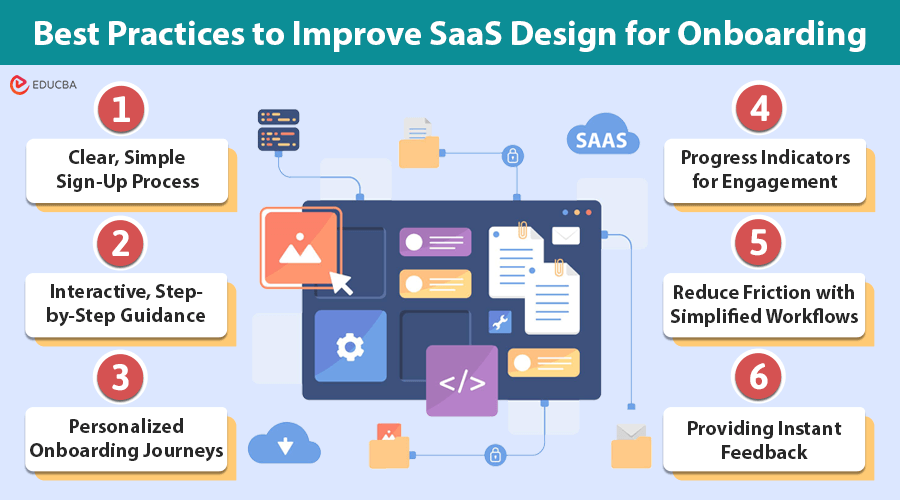
Overview
The first impression a user has of your SaaS platform often determines whether they’ll stick around or bounce. If onboarding is confusing or frustrating, it can lead to high churn rates and lost customers. This is where SaaS design services come into play. SaaS platforms that prioritize user-centric design can deliver seamless, intuitive onboarding experiences that captivate users from the start and drive lasting engagement.
Best Practices to Improve SaaS Design for Onboarding
1. Clear, Simple Sign-Up Process
A seamless sign-up is key to successful onboarding—if it’s too complex, users will drop off. SaaS design services streamline this process by minimizing steps and removing unnecessary fields, ensuring a hassle-free start.
For example, Instead of overwhelming users with lengthy forms, offer a one-click sign-up through Google or LinkedIn for a faster, frictionless experience. This makes the process quicker and more convenient, increasing conversion rates from the start.
2. Interactive, Step-by-Step Guidance
Users should feel confident exploring the platform when they enter it. Engaging interactive tutorials and guided tours that showcase key features and walk them through essential functions that make a difference.
Think of platforms like Trello or Asana, which offer in-app tips or “tool tips” to guide new users through basic functions. This allows users to become comfortable with the platform without experiencing confusion or stress. Well-designed onboarding flows can empower users to understand the platform’s value quickly.
3. Personalized Onboarding Journeys
Every user is different, and personalization plays a massive role in onboarding success. SaaS design services allow for customized onboarding based on user roles, preferences, or goals.
For instance, a project management tool might ask whether the user is an individual contributor, manager, or team leader and then offer tailored suggestions or onboarding flows suited to their role. By focusing on individual needs, users feel that the platform is built explicitly for them, leading to higher engagement.
4. Progress Indicators for Engagement
Users appreciate knowing their progress, making it essential to incorporate clear indicators that keep them motivated and on track during onboarding. Displaying users’ progress motivates them to complete the onboarding journey, much like a progress bar builds anticipation while downloading a file.
For instance, a progress tracker that shows “You’ve completed 50% of your profile setup” helps users understand that they’re getting closer to full functionality. This small but mighty feature enhances user satisfaction and prevents them from abandoning the platform midway through the setup.
5. Reduce Friction with Simplified Workflows
A big part of SaaS design is streamlining workflows and removing unnecessary steps that could frustrate users. By offering one-click billing setup and smart autofill options, you streamline the process, saving users from tedious tasks and keeping them focused on what truly matters.
Take Shopify, for example—it simplifies online store setup with quick-start templates and pre-filled options, reducing effort and getting users up and running in no time.
6. Providing Instant Feedback
Immediate feedback, whether encouraging or corrective, is a crucial component of successful onboarding. As users fill out forms or make decisions, providing real-time feedback reassures them they’re on the right track.
Think of an email marketing tool that shows users a green checkmark when they’ve successfully linked their email account or a red alert if something needs attention. Real-time notifications keep users informed and engaged, making the onboarding process interactive and rewarding.
7. Encourage User Exploration
Once the basics are covered, inspire users to dive in and explore the platform at their own pace. Guided actions like “Try out this feature” or “Explore the dashboard” motivate users to engage with advanced features in a non-overwhelming way.
This type of discovery can help users feel confident about using more sophisticated tools without a steep learning curve. For example, a SaaS platform may allow users to access “sandbox” environments where they can test features without affecting their real account.
Conclusion
A smooth and intuitive onboarding experience is the secret to keeping users engaged and unlocking long-term value in your platform. With Qubstudio’s expertise and a user-friendly design approach, SaaS products can transform first-time interactions from overwhelming to seamless, creating an engaging experience that keeps customers coming back. From personalized journeys to simple sign-up processes, well-executed design strategies are the foundation of user retention and SaaS success.
Recommended Articles
We hope this article on “SaaS Design for Onboarding” provided valuable insights. You can explore more of our recommended articles for further information:

